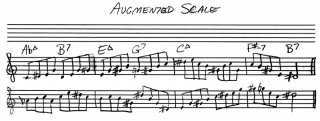I tend to arrive at things the hard way, which is to say, by personal discovery. For instance, I come across a large circular object and find that it has a unique quality, namely, that it rolls, and this gets me all excited, and of course I have to go tell all my friends. “Hey, Fred,” I say, rolling my circular object around on the lawn in front of him, “check this out! Pretty nifty, eh?”
“Ermmm, yeah. Nice. A wheel,” says Fred.
“A what?” I reply.
“A wheel,” Fred repeats, confirming my sudden suspicion that others may have already crossed this territory before me.
“Exactly, ” I say. “A wheel. Isn’t it great?”
Fred scrutinizes me for a second, then walks away. Now you know why I don’t have any friends named Fred. Used to, don’t anymore.
Anyway, the same principle probably applies to this post on using the augmented scale over “Giant Steps” changes. I’m sure it has already been done, and I’m probably just the last person to know about it. But since I haven’t come across any other literature that addresses the subject, either on the Internet or elsewhere, I thought I’d talk about it here.*
I do seem to recall reading somewhere about a connection between the augmented scale and the Coltrane tune, but it was just a passing comment that never went into any detail. I have no idea where I came across it. Evidently it planted a seed, though, because the relationship between the scale and the set of chord changes, both of whose symmetrical constructions emphasize the interval of a major third, has been intriguing me lately.
So earlier this evening, having thought the theory of the thing through, I finally sat down with my sax and my Jamie Aebersold “John Coltrane” CD and played around with the concept. It’s still very new to me, as is the sound of the augmented scale, but I’m satisfied at this point that I’ve acquired a very useful and colorful tool.
Simply put, the augmented scale is as close as you can get to a universal scale that covers “Giant Steps” in its entirety–not just the cantilevered dominant-tonic cycle, but also the ii-V7-I cadences. The application isn’t picture-perfect, but it works, and besides, a little dissonance is beautiful, right?
I’m not going to get deeply into the theory behind my thinking. I’m just going to assure you that, just as you can play an entire 12-bar blues using one blues scale, you can improvise on all of of “Giant Steps” using a single augmented scale. It’s not something you want to base an entire solo on, particularly since the augmented scale is such a foreign sound; but for that same reason, it’s also a very nice color to tap into, and you can coast along on it for as long as you please without having to think too much about making the changes. As long as you stay within the scale, you’re golden.
But of course, you want an example. So without further ado, here are a couple of licks on four bars of the “Giant Steps” cycle. Me being an alto man, I’ve written them for Eb instruments, so you may need to transpose. Click on the image to enlarge it.
Three points to be aware of:
• Use care in handling the perfect fourths of the dominant chords and the flatted thirds of the tonics.
• I’ve shown the standard chords without alterations. However, by virtue of its construction, the augmented scale works best with “Giant Steps” when you flat the ninths and raise the fifths of the dominant chords and flat the fifths of the minor sevenths.
• The sound of the augmented scale is quite different from everyday major/minor tonalities. So set those standards aside and suspend judgment until you’ve worked with the augmented scale long enough to get it into your ear.
That’s it. As for any further brain work, that’s up to you. Of course, you’re probably way ahead of me on it to begin with. That’s why, at this point, I’m turning my mind in other directions. For instance, I was sitting under an apple tree the other day, and an apple dropped off and bonked me on the head. I wondered why. What makes things fall? It’s almost like there’s some kind of a force or something. Has anyone looked into that?
They have?
Nuts. I was afraid of that.
————————–
* ADDENDUM: I take it back. After posting this article, I came across an excellent writeup by Jason Lyon that digs deeply into the theory of using the augmented scale with “Giant Steps.”


